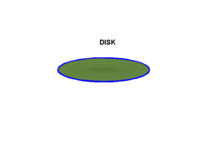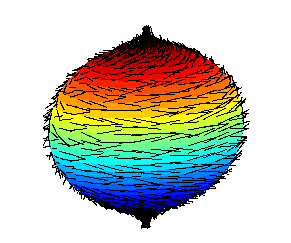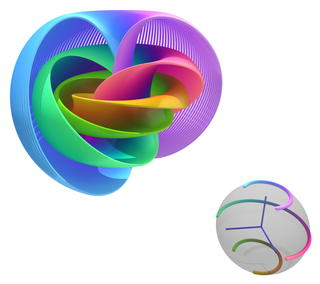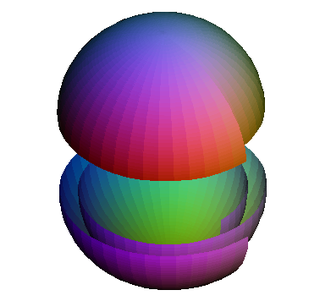Formal statement
Let M be an n-dimensional compact connected oriented manifold and the n-sphere and be continuous. Then if and only if f and g are homotopic.
The Hopf theorem (named after Heinz Hopf) is a statement in differential topology, saying that the topological degree is the only homotopy invariant of continuous maps to spheres.
Let M be an n-dimensional compact connected oriented manifold and the n-sphere and be continuous. Then if and only if f and g are homotopic.
Brouwer's fixed-point theorem is a fixed-point theorem in topology, named after L. E. J. (Bertus) Brouwer. It states that for any continuous function mapping a compact convex set to itself there is a point such that . The simplest forms of Brouwer's theorem are for continuous functions from a closed interval in the real numbers to itself or from a closed disk to itself. A more general form than the latter is for continuous functions from a convex compact subset of Euclidean space to itself.
In mathematics, a continuous function is a function that does not have any abrupt changes in value, known as discontinuities. More precisely, sufficiently small changes in the input of a continuous function result in arbitrarily small changes in its output. If not continuous, a function is said to be discontinuous. Up until the 19th century, mathematicians largely relied on intuitive notions of continuity, during which attempts such as the epsilon–delta definition were made to formalize it.

In mathematics, a diffeomorphism is an isomorphism of smooth manifolds. It is an invertible function that maps one differentiable manifold to another such that both the function and its inverse are smooth.

In topology and related areas of mathematics, the quotient space of a topological space under a given equivalence relation is a new topological space constructed by endowing the quotient set of the original topological space with the quotient topology, that is, with the finest topology that makes continuous the canonical projection map. In other words, a subset of a quotient space is open if and only if its preimage under the canonical projection map is open in the original topological space.

In mathematics, and particularly topology, a fiber bundle is a space that is locally a product space, but globally may have a different topological structure. Specifically, the similarity between a space and a product space is defined using a continuous surjective map
In mathematics, homotopy groups are used in algebraic topology to classify topological spaces. The first and simplest homotopy group is the fundamental group, which records information about loops in a space. Intuitively, homotopy groups record information about the basic shape, or holes, of a topological space.
In topology, a branch of mathematics, a fibration is a generalization of the notion of a fiber bundle. A fiber bundle makes precise the idea of one topological space being "parameterized" by another topological space. A fibration is like a fiber bundle, except that the fibers need not be the same space, nor even homeomorphic; rather, they are just homotopy equivalent. Weak fibrations discard even this equivalence for a more technical property.
In mathematics, a Hopf algebra, named after Heinz Hopf, is a structure that is simultaneously a algebra and a coalgebra, with these structures' compatibility making it a bialgebra, and that moreover is equipped with an antiautomorphism satisfying a certain property. The representation theory of a Hopf algebra is particularly nice, since the existence of compatible comultiplication, counit, and antipode allows for the construction of tensor products of representations, trivial representations, and dual representations.

The hairy ball theorem of algebraic topology states that there is no nonvanishing continuous tangent vector field on even-dimensional n-spheres. For the ordinary sphere, or 2‑sphere, if f is a continuous function that assigns a vector in R3 to every point p on a sphere such that f(p) is always tangent to the sphere at p, then there is at least one pole, a point where the field vanishes.

In the mathematical field of differential topology, the Hopf fibration describes a 3-sphere in terms of circles and an ordinary sphere. Discovered by Heinz Hopf in 1931, it is an influential early example of a fiber bundle. Technically, Hopf found a many-to-one continuous function from the 3-sphere onto the 2-sphere such that each distinct point of the 2-sphere is mapped from a distinct great circle of the 3-sphere. Thus the 3-sphere is composed of fibers, where each fiber is a circle — one for each point of the 2-sphere.

In the mathematical field of algebraic topology, the homotopy groups of spheres describe how spheres of various dimensions can wrap around each other. They are examples of topological invariants, which reflect, in algebraic terms, the structure of spheres viewed as topological spaces, forgetting about their precise geometry. Unlike homology groups, which are also topological invariants, the homotopy groups are surprisingly complex and difficult to compute.

In mathematics, the Poincaré–Hopf theorem is an important theorem that is used in differential topology. It is named after Henri Poincaré and Heinz Hopf.

In mathematical knot theory, the Hopf link is the simplest nontrivial link with more than one component. It consists of two circles linked together exactly once, and is named after Heinz Hopf.
In algebraic topology, a Steenrod algebra was defined by Henri Cartan (1955) to be the algebra of stable cohomology operations for mod cohomology.
In mathematics, the J-homomorphism is a mapping from the homotopy groups of the special orthogonal groups to the homotopy groups of spheres. It was defined by George W. Whitehead (1942), extending a construction of Heinz Hopf (1935).

In topology, the degree of a continuous mapping between two compact oriented manifolds of the same dimension is a number that represents the number of times that the domain manifold wraps around the range manifold under the mapping. The degree is always an integer, but may be positive or negative depending on the orientations.
In mathematics, in particular in algebraic topology, the Hopf invariant is a homotopy invariant of certain maps between n-spheres.
In the mathematical field of topology, a regular homotopy refers to a special kind of homotopy between immersions of one manifold in another. The homotopy must be a 1-parameter family of immersions.
In the mathematical field of low-dimensional topology, a clasper is a surface in a 3-manifold on which surgery can be performed.
This is a glossary of properties and concepts in algebraic topology in mathematics.
| This topology-related article is a stub. You can help Wikipedia by expanding it. |